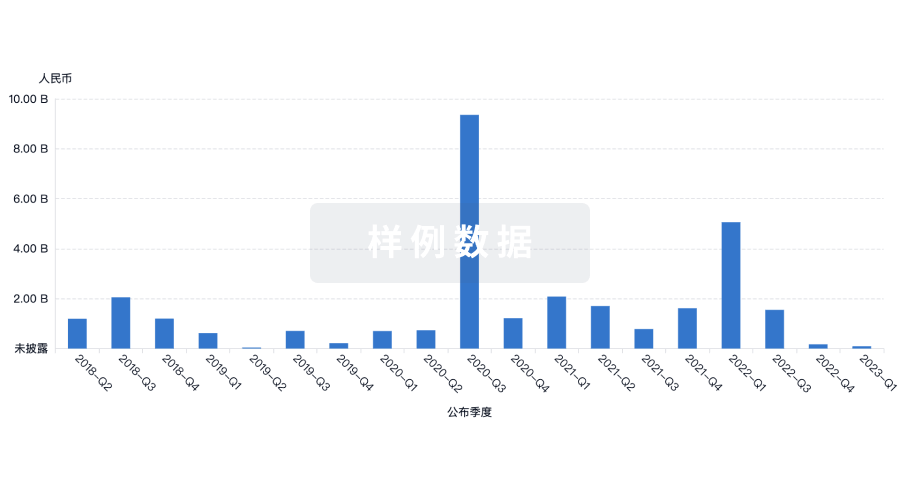预约演示
更新于:2025-07-06

University of Canberra
更新于:2025-07-06
概览
标签
神经系统疾病
皮肤和肌肉骨骼疾病
感染
小分子化药
疾病领域得分
一眼洞穿机构专注的疾病领域
暂无数据
技术平台
公司药物应用最多的技术
暂无数据
靶点
公司最常开发的靶点
暂无数据
| 排名前五的药物类型 | 数量 |
|---|---|
| 小分子化药 | 1 |
| 排名前五的靶点 | 数量 |
|---|---|
| MIF(巨噬细胞移动抑制因子) | 1 |
关联
1
项与 University of Canberra 相关的药物65
项与 University of Canberra 相关的临床试验ACTRN12625000027415
Inspire Beyond ICU” - Effect of inspiratory muscle training on quality of life in ICU patients requiring mechanical ventilation: a multicentre randomised trial
开始日期2025-07-01 |
申办/合作机构 |
ACTRN12624000966594
Investigating the effect of post-exercise serum biomarkers in healthy volunteers on keratinocyte cancer cell lines
开始日期2024-08-26 |
申办/合作机构 |
ACTRN12624000827538
On-site Pharmacist Implementation Trial In Residential Aged Care Homes in Urban, Regional, Rural and Remote (OPTIMISER3) Australia
开始日期2024-07-08 |
申办/合作机构 |
100 项与 University of Canberra 相关的临床结果
登录后查看更多信息
0 项与 University of Canberra 相关的专利(医药)
登录后查看更多信息
4,552
项与 University of Canberra 相关的文献(医药)2025-12-01·Journal of Sport and Health Science
Iron deficiency, supplementation, and sports performance in female athletes: A systematic review
Review
作者: Etxebarria, Naroa ; Pumpa, Kate ; Pyne, David Bruce ; Pengelly, Michael
BACKGROUND:
Iron facilitates key biological functions underpinning sports performance, and up to 60% of female athletes experience iron deficiency. However, the effects of iron deficiency on sports performance in female athletes is unclear, as are the degree of benefits of iron supplementation (FeSup). This study characterizes the effects of iron deficiency and FeSup on sports performance in high-level female athletes.
METHODS:
Searches of the electronic databases MEDLINE, SPORTDiscus, Web of Science, Scopus, and CINAHL were performed in July 2023. Studies were included that evaluated the effects of iron deficiency or FeSup on sports performance in high-level (maximal oxygen uptake (VO2max) > 45 mL/kg/min, or trained > 5 h/week) iron deficient (ID) (serum ferritin (sFer) < 40 µg/L) female athletes. Studies were assessed using a modified Downs and Black Quality Assessment Checklist.
RESULTS:
A total of 23 studies comprising 669 athletes (age range: 13-47 years) across 16 sports were included in the review. Iron deficiency negatively affects endurance performance by 3%-4%. However, endurance performance improved by 2%-20% when ID athletes were treated with 100 mg/day of elemental iron for up to 56 days via oral supplementation, or bi-daily via parenteral administration over 8-10 days. ID non-anemic athletes with low sFer stores may be predisposed to reduced maximal aerobic capacity. However, maximal aerobic capacity improved by 6%-15% following 16 mg/day-100 mg/day of elemental iron for 36-126 days. Isokinetic strength and anaerobic power performance may be impeded (-23% to +4%) among ID athletes, but the effect of FeSup on anaerobic power varied markedly (-5% to +9%) following 100 mg/day of elemental iron over 42-56 days, or 100 mg of elemental iron bi-daily over 8-10 days. The quality of studies was moderate (77%), ranging from low (57%) to high (100%). Moststudies (n = 18) contained group sizes ≤ 20 athletes, thus limiting the likelihood of detecting significant effects (statistical power > 0.80).
CONCLUSION:
High-level ID female athletes experience a negative impact on endurance performance, which can be improved by supplementing with ∼100 mg of elemental iron per day or bi-daily. The decrements in other performance parameters characterizing a range of sports coincide with the severity of iron deficiency.
2025-12-01·IMMUNOGENETICS
Genome-wide diversity and MHC characterisation in a critically endangered freshwater turtle susceptible to disease
Article
作者: Hogg, Carolyn J ; Kovacs, Toby G L ; McLennan, Elspeth A ; Silver, Luke ; Belov, Katherine ; DeGabriel, Jane L ; Nelson, Holly V ; Georges, Arthur
Abstract:
Small, isolated populations are often vulnerable to increased inbreeding and genetic drift, both of which elevate the risk of extinction. The Bellinger River turtle (Myuchelys georgesi) is a critically endangered species endemic to a single river catchment in New South Wales, Australia. The only extant wild population, along with the breeding program, face significant threats from viral outbreaks, most notably a nidovirus outbreak in 2015 that led to a 90% population decline. To enhance our understanding of genomic characteristics in the species, including genome-wide and functional gene diversity, we re-sequenced, assembled, and analysed 31 re-sequenced genomes for pure M. georgesi (N = 31). We manually annotated the major histocompatibility complex (MHC), identifying five MHC class I and ten MHC class II genes and investigated genetic diversity across both classes in M. georgesi. Our results showed that genome-wide diversity is critically low in pure M. georgesi, contexualised through comparison with opportunistically sampled backcross animals—offspring of F1 hybrids (M. georgesi × Emydura macquarii) backcrossed to pure M. georgesi (N = 4). However, the variation observed within the core MHC region of pure M. georgesi, extending across scaffold 10, exceeded that of all other macrochromosomes. Additionally, no significant short-term changes in either genome-wide or immunogenetic diversity were detected following the 2015 nidovirus outbreak (before; N = 19, after; N = 12). Demographic history reconstructions indicated a sustained, long-term decline in effective population size since the last interglacial period, accompanied by more recent steep declines. These patterns suggested that prolonged isolation and reduced population size have significantly influenced the dynamics of genome-wide diversity. It is likely that contemporary stressors, including the recent nidovirus outbreak, are acting on an already genetically depleted population. This study offers new insights into genome-wide and immune gene diversity, including immune gene annotation data with broader implications for testudines. These findings provide crucial information to support future management strategies for the species.
2025-12-01·Journal of Sport and Health Science
Are there sensitive periods for physical activity to influence the development of executive function in children?
Review
作者: Hillman, Charles H ; Raine, Lauren B ; Northey, Joseph M
Executive functions emerge throughout childhood and shape multiple cognitive and behavioral outcomes across the lifespan. Given the importance of these functions, there is considerable interest in understanding the role of environmental enrichment to support their development. The past 20 years have seen the emergence of a body of evidence around the beneficial effects of engaging in physical activity for executive functioning in children. Despite this, there are still unanswered questions, particularly about the confounding effects of the timing and dose of exercise-based interventions. During development, sensitive periods with heightened neural plasticity and sensitivity to environmental influences can offer an optimal time to introduce enrichment interventions. As such, sensitive periods for executive function could indicate an ideal time to introduce physical activity or be a potential confounder to study results if not considered. This narrative review discusses the potential presence of sensitive periods in preadolescent development where physical activity has greater benefits for executive function. Initially, we briefly review the largely parallel fields investigating the presence of sensitive periods for executive function and the effects of physical activity on executive function outcomes. We then bring together these 2 concepts to discuss the theoretical basis for developmentally sensitive periods during which children may be particularly amenable to physical activity-based interventions and offer potential ways forward to investigate this phenomenon. We hope this review will attract researchers to collaborate in the area and extend our current understanding of the development of executive functions as well as interventions like physical activity.
6
项与 University of Canberra 相关的新闻(医药)2024-01-12
·生物谷
众所周知,浪漫的爱情会改变大脑,释放所谓的爱情激素——催产素(oxytocin),这正是我们坠入爱河时所感受到的愉悦感。
近日,来自澳大利亚国立大学、堪培拉大学和南澳大利亚大学的研究人员在 Behavioral Sciences 期刊发表了题为:Romantic Love and Behavioral Activation System Sensitivity to a Loved One 的研究论文。
众所周知,浪漫的爱情会改变大脑,释放所谓的爱情激素——催产素(oxytocin),这正是我们坠入爱河时所感受到的愉悦感。
这项研究进行了世界首个调查人类大脑行为激活系统(BAS)与浪漫爱情之间联系的研究,测量了大脑是如何在第一次浪漫的冲动中将我们所爱之人推上神坛的。
在这项研究中,研究团队调查了1556名处于恋爱中的年轻人。调查问题集中在对爱人的情感反应、行为以及他们对爱人的关注程度。事实证明,当我们坠入爱河时,我们的大脑会做出不同的反应,使得我们情感的对象成为我们生活的中心。这项研究表明爱情与行为和情感的变化有关。
具体来说,在研究1中,行为激活系统-对爱人的敏感性(BAS-SLO)量表在1556名正处于浪漫爱情中的年轻人中得到验证。在研究2中,使用分层线性回归在812名经历浪漫爱情不到两年的年轻人中确定了BAS-SLO量表与浪漫爱情强度的关联。BAS-SLO量表解释了浪漫爱情强度变异的8.89%。在进一步验证和测试的情况下,BAS-SLO量表可能在未来的神经成像和心理学研究中发挥作用。综合来看,这两项研究表明,大脑的行为激活系统(BAS)对所爱之人的敏感度是一种真实存在的现象,并且浪漫爱情的状态可能与BAS对所爱之人的敏感度有关。这对于理解浪漫爱情的机制和演化历史具有重要意义。
众所周知,催产素在浪漫爱情中的重要作用,当我们与所爱之人互动时,催产素会在我们的神经系统和血液中循环。然而,爱上一个人之所以显得特别重要,是因为催产素和多巴胺结合,多巴胺是我们的大脑在浪漫爱情中释放的一种化学物质。从本质上讲,爱情激活了大脑中与积极情绪相关的通路。
研究团队表示,我们实际上对爱情的演变知之甚少,因此,每一个告诉我们浪漫爱情演变的发现都是刚刚开始的研究拼图中的重要一块。接下来,研究团队将进一步调查男性和女性在恋爱方式上的差异,并将开展一项全球调查,确定四种不同类型的浪漫恋人。
2024-01-09
Love is blind, the saying goes, and thanks to a new study we are now a step closer to understanding why. Researchers have measured how a part of the brain is responsible for putting our loved one on a pedestal in that first flush of romance.
Love is blind, the saying goes, and thanks to a world-first Australian study, we are now a step closer to understanding why.
It is well known that romantic love changes the brain, releasing the so-called love hormone oxytocin, responsible for the euphoria we feel when falling in love.
Now, researchers from the ANU, University of Canberra and University of South Australia have measured how a part of the brain is responsible for putting our loved one on a pedestal in that first flush of romance.
In the world's first study investigating the link between the human brain's behavioural activation system (BAS) and romantic love, researchers surveyed 1556 young adults who identified as being "in love."
The survey questions focused on the emotional reaction to their partner, their behaviour around them, and the focus they placed on their loved one above all else.
It turns out that when we are in love, our brain reacts differently. It makes the object of our affections the centre of our lives.
ANU lead researcher and PhD student Adam Bode says the study -- recently published in the journal Behavioural Sciences - sheds light on the mechanisms that cause romantic love.
"We actually know very little about the evolution of romantic love," Bode says. As a result, every finding that tells us about romantic love's evolution is an important piece of the puzzle that's just been started."
"It is thought that romantic love first emerged some five million years ago after we split from our ancestors, the great apes. We know the ancient Greeks philosophized about it a lot, recognising it both as an amazing as well as traumatic experience. The oldest poem ever to be recovered was in fact a love poem dated to around 2000 BC."
University of Canberra academic and UniSA Adjunct Associate Professor, Dr Phil Kavanagh, says the study shows that romantic love is linked to changes in behaviour as well as emotion.
"We know the role that oxytocin plays in romantic love, because we get waves of it circulating throughout our nervous system and blood stream when we interact with loved ones," Dr Kavanagh says.
"The way that loved ones take on special importance, however, is due to oxytocin combining with dopamine, a chemical that our brain releases during romantic love. Essentially, love activates pathways in the brain associated with positive feelings."
The next stage of the research involves investigating the differences between men and women in their approach to love, and a worldwide survey identifying four different types of romantic lovers.
2023-11-07
Primus CF steering wheel. Photo credit: Cobra International, Schmitt Marine
Cobra International (Chonburi, Thailand) has announced its latest marine industry collaboration with Schmitt Marine (Lancaster, Pa., U.S.). A provider of performance steering wheel systems, Schmitt Marine has joined forces with Cobra and engineering firm Talon Technology (Springfield, Mo., U.S.) to create the new Primus CF wheel.
Looking to offer carbon fiber as a top-of-the-range option for premium vessel owners, Schmitt Marine aims to combine the style of its classic steel wheel designs with a new, strong and lightweight carbon fiber composite construction.
Working together with engineer Geoff Germon, CEO of Talon Technology Pty. Ltd. and adjunct professor of design at the University of Canberra (Australia), Cobra concentrated on creating a production methodology for the Primus CF that could seamlessly transfer parts from tool to polyurethane (PU) clear coating with minimum process steps and materials.
As a result, the wheel’s carbon fiber prepreg skins, featuring UV-resistant black Santoprene rubber grip patches, have been combined with a toughened epoxy glass fiber core to create a luxury-grade carbon fiber steering wheel that has been optimized to meet all NMMA and CE testing regulations for U.S. and European end markets.
“Talon and Cobra have shown how easy it is to switch to composites,” Jed Schober, product development specialist, Schmitt Marine, says. “They have created an innovative design and production process that improves performance at a smart price point. Thanks to Cobra’s commitment to product quality and on-time delivery, we’re creating a stronger and lighter future for our customers.”
100 项与 University of Canberra 相关的药物交易
登录后查看更多信息
100 项与 University of Canberra 相关的转化医学
登录后查看更多信息
组织架构
使用我们的机构树数据加速您的研究。
登录
或

管线布局
2025年08月12日管线快照
管线布局中药物为当前组织机构及其子机构作为药物机构进行统计,早期临床1期并入临床1期,临床1/2期并入临床2期,临床2/3期并入临床3期
临床前
1
登录后查看更多信息
药物交易
使用我们的药物交易数据加速您的研究。
登录
或

转化医学
使用我们的转化医学数据加速您的研究。
登录
或

营收
使用 Synapse 探索超过 36 万个组织的财务状况。
登录
或

科研基金(NIH)
访问超过 200 万项资助和基金信息,以提升您的研究之旅。
登录
或

投资
深入了解从初创企业到成熟企业的最新公司投资动态。
登录
或

融资
发掘融资趋势以验证和推进您的投资机会。
登录
或

Eureka LS:
全新生物医药AI Agent 覆盖科研全链路,让突破性发现快人一步
立即开始免费试用!
智慧芽新药情报库是智慧芽专为生命科学人士构建的基于AI的创新药情报平台,助您全方位提升您的研发与决策效率。
立即开始数据试用!
智慧芽新药库数据也通过智慧芽数据服务平台,以API或者数据包形式对外开放,助您更加充分利用智慧芽新药情报信息。
生物序列数据库
生物药研发创新
免费使用
化学结构数据库
小分子化药研发创新
免费使用
